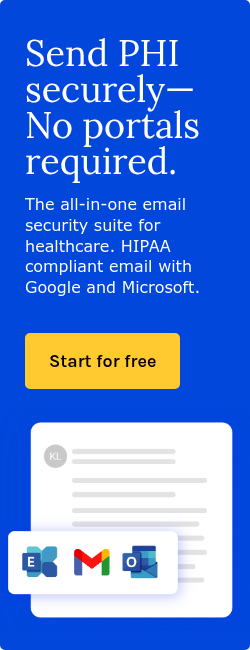
In 2025, technology has become a part of healthcare. From AI-powered diagnostics and virtual consultations to wearable health devices and cloud-based electronic health records (EHRs), digital tools are transforming how care is delivered and experienced. These advancements are helping providers detect disease earlier, personalize treatment, and improve access to care.
But with this innovation comes a new challenge: protecting the vast amounts of sensitive health data generated daily. As healthcare becomes more digital, ensuring HIPAA compliance and strong data security is more critical than ever.
The rise of technology in healthcare
Technology has revolutionized healthcare delivery and administration. Key developments include:
Electronic health records (EHRs): Validated in 1991, EHRs have replaced paper records, facilitating real-time access to patient information and improving care coordination. Similar to paper records, EHRs hold the “key administrative clinical data relevant to that person's care under a particular provider, including demographics, progress notes, problems, medications, vital signs, past medical history, immunizations, laboratory data and radiology reports,” says the Centers for Medicare & Medicaid Services. Maintaining an EHR can improve patient care by:
- “Reducing the incidence of medical error by improving the accuracy and clarity of medical records.
- Making the health information available, reducing duplication of tests, reducing delays in treatment, and keeping patients well informed to make better decisions.
- Reducing medical error by improving the accuracy and clarity of medical records.”
Telemedicine: In the study The State of Telehealth Before and After the COVID-19 Pandemic by Julia Shaver, it is said that “Before March 2020, telemedicine use in the United States was on a steadily increasing trajectory, but its absolute integration remained low, and the logistics were complex.” The COVID-19 pandemic accelerated the adoption of telehealth services, enabling remote consultations and reducing barriers to care. “In response, practices greatly expanded telemedicine services during the long months of shelter in place and recurrent surges of COVID-19 infections, and patient use of telehealth services blossomed. A national study including 36 million working-age individuals with private insurance claims data showed that telemedicine encounters increased 766% in the first 3 months of the pandemic, from 0.3% of all interactions in March to June 2019, to 23.6% of all interactions in the same period.”
Artificial Intelligence (AI): AI algorithms assist in diagnostics, predictive analytics, and personalized treatment plans, enhancing clinical decision-making. Published in 2024 is the study Advancing clinical decision support: The role of artificial intelligence across six domains, which found that AI significantly improves diagnostic accuracy, enables predictive analytics for patient outcomes, and supports personalized treatment planning tailored to individual needs. Additionally, AI streamlines clinical workflows, reduces clinician workload through automation, enhances continuous patient monitoring, and improves resource allocation across healthcare systems. Overall, the integration of AI into CDSS is shown to boost both clinical efficiency and patient care quality.
Wearable devices: Fitness trackers and medical wearables are health-monitoring tools that can assist in preventive care and chronic disease management by tracking vital signs, alerting healthcare providers to early complications, and enabling timely interventions. These wearables empower patients to take charge of their health, providing daily feedback on physical activity, nutrition, and wellness.
Blockchain technology: “Blockchain applications can accurately identify severe mistakes and even dangerous ones in the medical field. Thus, it can improve the performance, security, and transparency of sharing medical data in the health care system,” writes Abid Haleem et al. in a study titled Blockchain technology applications in healthcare: An overview.
Impact of technology on healthcare
The integration of digital technologies has impacted nearly every aspect of healthcare, from patient outcomes to operational efficiency. These innovations are not only changing how medical professionals diagnose and treat illness but also how patients engage with their health.
Improved patient outcomes
One of the most significant benefits of healthcare technology is the enhancement of patient outcomes. Early detection and intervention have become more attainable with the help of AI-driven diagnostic tools, continuous monitoring via wearables, and remote care through telemedicine. For example, AI models can detect diseases such as cancer, diabetic retinopathy, and cardiovascular conditions with remarkable accuracy by analyzing imaging scans, pathology slides, or genetic data. Wearables continuously gather data on vital signs such as heart rate, blood pressure, and oxygen levels, offering real-time insights that can prompt earlier clinical responses and help prevent complications.
Moreover, cloud-based EHRs allow providers to easily access a patient’s complete health history, avoiding redundant tests and improving the accuracy of diagnoses. This facilitates a more cohesive treatment plan and encourages collaboration between primary care providers and specialists.
Read also: How empowering patients leads to better health outcomes
Increased access to care
Digital health tools have expanded access to healthcare, especially for individuals in rural or underserved areas. Through telemedicine, patients can consult with physicians from the comfort of their homes, eliminating travel time and reducing missed appointments. This is particularly beneficial for individuals with limited mobility, chronic conditions, or caregiving responsibilities.
Similarly, mobile health (mHealth) apps provide self-management tools, health education, and medication reminders that promote adherence to treatment regimens. These apps also bridge the gap between visits, allowing patients to track symptoms and communicate with their healthcare providers more effectively.
Enhanced operational efficiency
From an administrative standpoint, digital technologies improve the efficiency of healthcare systems. Automated scheduling, billing, and prescription refill systems reduce administrative burden, allowing healthcare professionals to focus more on patient care. AI-powered clinical decision support systems (CDSS) can help clinicians make evidence-based decisions faster, reducing diagnostic errors and streamlining workflows.
Additionally, predictive analytics can anticipate patient surges in emergency rooms, identify patients at risk of readmission, and help manage chronic conditions more proactively. Hospitals and clinics benefit from improved resource allocation and cost savings, ultimately leading to a better standard of care.
Risks and challenges in digital healthcare
Despite the many benefits, the rapid digitization of healthcare also introduces a new set of challenges, particularly concerning patient privacy, data security, and regulatory compliance.
Data privacy concerns
Digital systems, while convenient, create multiple points of vulnerability for cyberattacks and data breaches. According to Statista “1.35 billion individuals were affected in the same year by data compromises, including data breaches, leakage, and exposure.”
With the adoption of internet-connected devices and cloud-based systems, ensuring the integrity and confidentiality of patient data becomes increasingly complex. An example that demonstrates the complexities of ensuring data integrity and confidentiality in the era of internet-connected healthcare devices is the 2024 incident involving Confidant Health. Security researcher Jeremiah Fowler discovered an unsecured database containing over 120,000 files and 1.7 million activity logs from this virtual medical provider. The exposed data included detailed medical histories, as well as audio and video recordings of therapy sessions. This breach was attributed to improper configuration, where some files were accessible without password protection, underscoring the risks associated with misconfigured cloud-based systems in healthcare. Any failure to safeguard this data jeopardizes patient trust and exposes organizations to legal and financial penalties.
HIPAA compliance
In the United States, the Health Insurance Portability and Accountability Act (HIPAA) sets national standards for the protection of health information. Covered entities and their business associates must implement administrative, physical, and technical safeguards to protect electronic protected health information (ePHI).
These requirements fall under HIPAA’s Technical Safeguards and include access controls, audit trails, data encryption, employee training, and risk assessments. While these protocols are essential, keeping up with evolving threats and maintaining compliance across an expanding digital ecosystem can be resource-intensive and challenging.
Interoperability and data fragmentation
Another major hurdle is interoperability—the ability of different health IT systems and devices to share, interpret, and use information cohesively. Although EHR adoption has been widespread, many systems are still unable to communicate effectively due to proprietary platforms, inconsistent data standards, or regulatory restrictions.
Fragmentation can hinder care coordination, delay treatment decisions, and create administrative burdens as clinicians navigate through multiple systems to gather complete patient information. Efforts such as the Fast Healthcare Interoperability Resources (FHIR) standard aim to solve this problem, but widespread adoption remains a work in progress.
Read also: How does email ensure interoperability?
Striking the balance: innovation vs. regulation
As healthcare technology continues to evolve, striking the right balance between innovation and regulation will be essential. Policymakers, developers, and providers must work together to ensure that digital health tools enhance care without compromising privacy, safety, or ethical standards.
This includes updating existing regulations like HIPAA to reflect modern data-sharing practices, encouraging the adoption of interoperable systems, and investing in cybersecurity infrastructure. Likewise, healthcare organizations must foster a culture of data responsibility, where employees are trained to recognize threats and follow best practices in data handling.
See also: HIPAA Compliant Email: The Definitive Guide (2025 Update)
FAQS
Is healthcare data stored digitally safe?
Yes, especially with technologies like blockchain and encryption protocols in place. Additionally, compliance with regulations like HIPAA helps ensure that digital health data is kept confidential, secure, and accessible only to authorized parties.
What’s next for technology in healthcare?
Looking ahead, we can expect more integration of AI, greater use of predictive analytics, increased adoption of remote monitoring tools, and the rise of decentralized data sharing models. All of this points toward more proactive, personalized, and patient-centered care.
Subscribe to Paubox Weekly
Every Friday we'll bring you the most important news from Paubox. Our aim is to make you smarter, faster.




